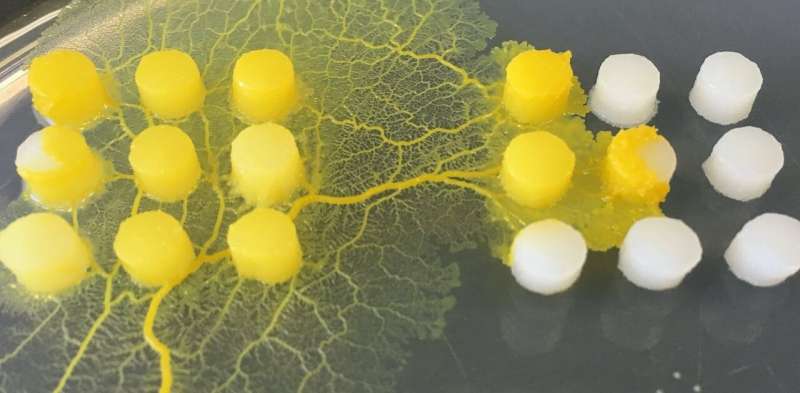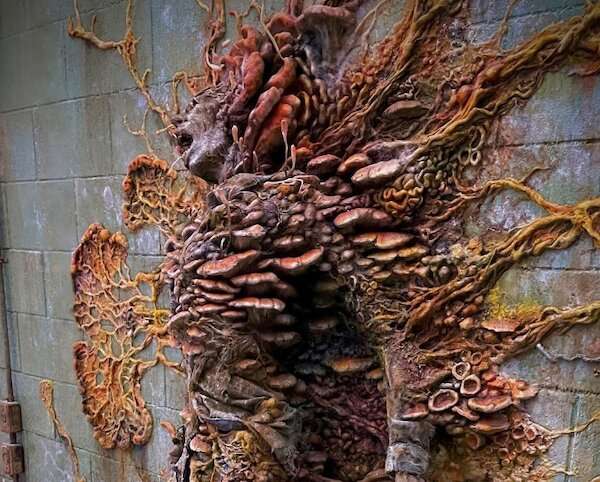This article has been reviewed according to Science X's editorial process and policies. Editors have highlighted the following attributes while ensuring the content's credibility:
fact-checked
trusted source
written by researcher(s)
proofread
Slime molds are not actually fungi at all, but they are brainless predators

In HBO's post-apocalyptic drama "The Last of Us," human civilization has fallen in the face of a fungal takeover triggered by climate change.
The show's opening credits and creature designs are inspired by the slime mold Physarum polycephalum. But while the show's "infected" (i.e. zombies) are meant to be victims of a fungal pandemic, slime molds are not actually fungi at all.
They are in fact much more ancient, and less closely related to fungi than even we are. Since scientists first tried to classify slime molds, they have been wrongly grouped with plants, animals, and in particular, fungi.
This is because they typically occur in the same ecosystems as fungi, and because they produce structures to help spread their spores, much like their fungal cousins do.
Molecular methods for grouping lifeforms by comparing their DNA have helped us better understand slime molds' distinct heritage. Yet their exact place on the tree of life is still unclear.
A fierce predator
Despite bearing a superficial similarity to fungi, there are many aspects of the slime mold's biology that are strikingly unique. This yellow blob of goo may not look like much, but it is in fact a fierce predator of bacteria, yeasts and other microorganisms, including fungi.
Though they can grow quite large—up to several square meters across—each slime mold is a single cell, containing millions of nuclei and all the other complex machinery that lies inside cells like ours.
The slime mold's "body" is a network of veins and tubes that can move at the rapid pace of up to five centimeters per hour to locate and capture their prey.
Inside the slime mold, a rich soup of cell components and food particles flows back and forth within the network. This flow transmits nutrients, chemical signals and information between different regions of the slime mold.
These rippling, sprawling movements are likely what makes slime mold so appealingly creepy to horror artists and filmmakers.
Zombie intelligence
Slime mold physiology and anatomy is as alien as it is fascinating. But it's their behavior that separates them from their peers, and perhaps mirrors our own a little too closely for comfort.

Far from being simple cells moving blindly through the leaf litter, slime molds can gather a huge amount of information from their environment, and use it to make smart decisions about where to move and look for food, much like the infected in "The Last of Us," which operate as one large organism in search of prey.
So far, the slime mold has been shown to sense and move toward or away from carbohydrates, proteins, amino acids, free nucleotides, volatile organic chemicals, salts, pH, light, humidity and temperature, even sensing the direction of gravity and magnetic fields.
When a slime mold finds several food sources at the same time, it tries to cover each food with as much of itself as it can (to absorb it), without splitting into disconnected individuals. The most efficient way to do this is to have a single tube connecting the two foods along the shortest path between them.
Slime molds have evolved over millions of years to become master network engineers. They are expert maze-solvers, and researchers have begun to build computer algorithms for the design of human train and telecommunication networks based on slime mold approaches.
No brain? No problem
Slime molds' problem-solving abilities are all the more fascinating because the creature doesn't have a brain or even a single neuron. Nevertheless, they show signs of memorization and even learning—two things which traditionally were thought possible only in animals with brains.
As they move, slime molds leave behind a trail of slime similar to mucous. This slime trail serves as an externalized memory of areas it has explored in the past, which is very useful for solving mazes.
They can distinguish between their own trails, their neighbors," and those of other slime mold species. They also use food signals left behind in the trails to judge their own chances of finding food in an area.
Researchers have also found slime molds can learn to ignore a substance they normally find repellent (such as quinine or caffeine) after prolonged exposure. Researchers call this basic form of learning "habituation."
Amazingly, when a habituated slime mold fuses together with an untrained slime mold (oh yeah, they can do that), the learned behavior is observed in the new combined individual.
All this raises the (somewhat creepy) question: what other kinds of knowledge do slimy creatures pass between each other as they crawl beneath the forest floor?
Provided by The Conversation
This article is republished from The Conversation under a Creative Commons license. Read the original article.![]()



















